
The County of Urgell is one of the historical Catalan counties, bordering on the counties of Pallars and Cerdanya.

Ramon Berenguer IIIthe Great was the count of Barcelona, Girona, and Ausona from 1086, Besalú from 1111, Cerdanya from 1117, and count of Provence in the Holy Roman Empire, from 1112, all until his death in Barcelona in 1131. As Ramon Berenguer I, he was Count of Provence in right of his wife.
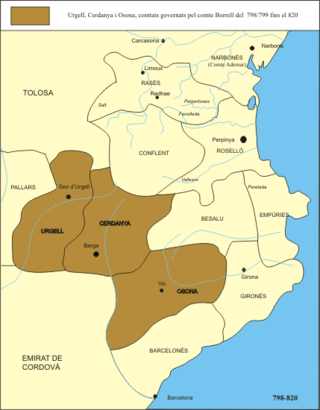
The County of Osona, also Ausona, was one of the Catalan counties of the Marca Hispanica in the Early and High Middle Ages. It was based around the capital city of Vic (Vicus) and the corresponding diocese, whose territory was roughly the current comarca of Osona.

Borrell II was Count of Barcelona, Girona and Ausona from 945 and Count of Urgell from 948.

Berenguer Ramon I [Berengar Raymond I], called the Crooked or the Hunchback, was the count of Barcelona, Girona, and Ausona from 1018 to his death.
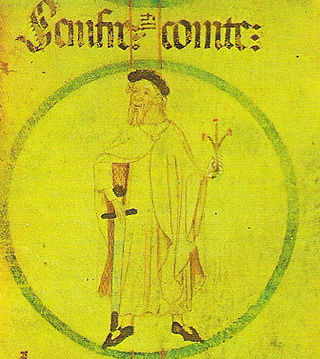
Sunyer was count of Barcelona, Girona and Ausona from 911 to 947.

The County of Barcelona was originally a frontier region under the rule of the Carolingian dynasty. In the 10th century, the Counts of Barcelona became progressively independent, hereditary rulers in constant warfare with the Islamic Caliphate of Córdoba and its successor states. The counts, through marriage, alliances and treaties, acquired the other Catalan counties and extended their influence over Occitania. In 1164, the County of Barcelona entered a personal union with the Kingdom of Aragon. Thenceforward, the history of the county is subsumed within that of the Crown of Aragon, but the city of Barcelona remained preeminent within it.

Borrell I was the first count of Cerdanya, Urgell, and Osona from between 797 and 799 to his death in 820. He was a Visigoth nobleman, probably from Cerretana (Cerdanya).

Saint Ermengol or Hermengaudius was the bishop of Urgell from 1010.

The Catalan counties were the administrative Christian divisions of the eastern Carolingian Hispanic Marches and the southernmost part of the March of Gothia in the Pyrenees created after their rapid conquest by the Franks.
The County of Cerdanya was one of the Catalan counties formed in the last decades of the 8th century by the Franks in the Marca Hispanica. The original Cerdanya consisted of the valley of the upper Segre. Today Cerdanya is a Catalan comarca.
ErmengolVIII, known as el de Sant Hilari, was the Count of Urgell from 1184 to his death. He was a son of Ermengol VII and Dulce, daughter of Roger III of Foix.
Ermengol VII was the Count of Urgell from 1154 to his death. He was called el de Valencia.
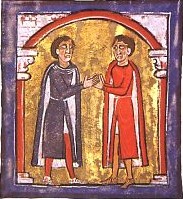
ErmengolIII, called el de Barbastro, was the count of Urgell from 1038 to his death. He was the son of Ermengol II, Count of Urgell and his wife Velasquita "Constance", probably the daughter of Bernard I, Count of Besalú.
Guerau IV de Cabrera (1196–1229) was a claimant to the County of Urgel during the time that James I of Aragon was King of Aragon. His uncle, Ponç III of Cabrera, married the daughter of Ermengol VII named Marquesa in 1194. Also, Marquesa’s father, Ermengol VII, was the son of Ermengol VI and his first wife, Arsenda of Cabrera. Through these familial ties to the House of Cabrera, Gerau came to claim the County of Urgell.
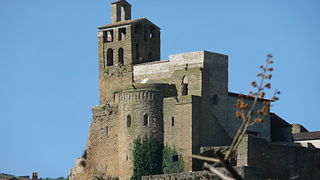
The Viscounty of Àger was a feudal jurisdiction that branched off the County of Urgell in 1094.
Wilfred or Wifred, called the Hairy, was Count of Urgell, Cerdanya, Barcelona, Girona, Besalú and Ausona. On his death in 897, his son, Wilfred Borrell, inherited these Catalan counties.
The Battle of Mollerussa took place in the south of the county of Urgell on 11 or 14 September 1102. In the battle, Count Ermengol V was defeated and killed by an Almoravid army. Mollerussa lies halfway between Bellpuig and Lleida and is the largest town in the Pla d'Urgell.
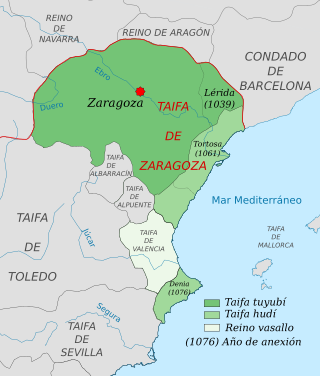
The Taifa of Lérida was a factional kingdom (ṭāʾifa) in Muslim Iberia between 1039/1046 and 1102/1110. Based on the city of Lérida, the ṭāʾifa was not an independent state throughout this period but was sometimes a part of the larger ṭāʾifa of Zaragoza ruled by a governor (wālī).
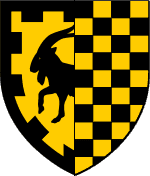
Ponce I, Count of Urgell was Count of Urgell in Catalonia from 1236 until his death.














